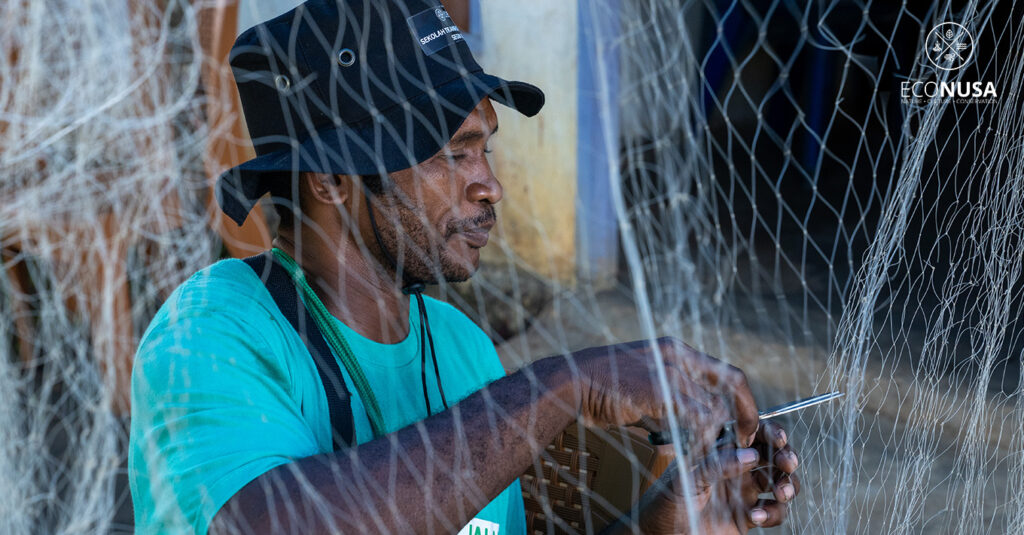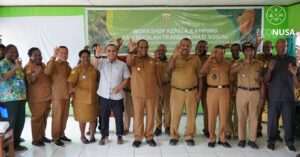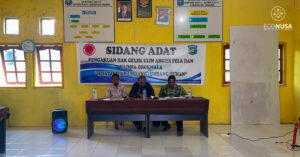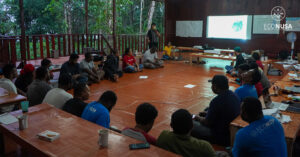
Yefta Fadan observantly observed the breaded nylon thread stretching before him. When his other fellows were playing a joke, Yefta kept silent. His fingers tracked every single line of nylon thread to avoid mistaken cut of the fishing net that has been broken. Mistaken cut of the broken fishing net will extend the fixing time and break up the net pattern.
“Fixing the net is not easy job. We should cut the broken net first, but it is not easy either. Mistaken cut will damage the net,” said Yefta while knitting the nylon thread on Thursday, 6 October 2022 at the neighbor’s yard in Segun Village, Segun District, Sorong Regency.
Besides, there were some other youngsters took part in skill enrichment on how to fix the fishing net. They came from seven villages in three districts in Sorong Regency, namely Segun, Malamas, Gisim, Klajarin, Waimon Villages in Segun District, Ningjemur Village in Moisegen District, and Kasimle Village in Seget District.
Read also: Hoping for Land road in Segun District
Fixing net is one of the materials of fishery class during the Social Transformation school (STS) in Segun Village. In addition, the STS participants also attended organic farming class by planting taro, pepper, and vegetables, and gardening class with sago cultivation and processing lessons.
Yefta has been familiar with fisheries since he was 18. Waimon Village which is adjacent to Seram Sea makes the locals accustomed to processing the abundant fishery resources. Unfortunately, the condition does not go in line with sufficient market and community capacity.
Not all the local fishery catches hit the market. Customers seem uninterested with fresh fish. Snapper, parrot fish, grouper, and baronang fish merely end up on the household tables. The customers are interested in the salted fish. “Fresh fish costs Rp5,000 per kilogram. It fails to cover fuel cost. It differs from the salted fish which cost Rp40,000 per kilogram,” added Yefta.
Read also: Nutmeg Tale of Kaimana, from Nursery to Training on Shaky Nutmeg
Lobster is the only commodity that could hit the market. When the water is on half high tide or locally called konda, and clean, the locals could collect one hundred pieces of lobster a day. When the current is strong with murky visibility, only fifteen pieces of lobster could be caught in a day. “We sell the lobster to a middleman. It costs Rp70,000 per kilogram. When the sea current is good, we could get more than 200 kilograms. For instance, collecting 300 kilograms of catches could earn Rp21 million which is deducted by fuel and miscellaneous costs. In one diving, it consumes 25 liters of fuel,” said Yefta.
In addition to fuel, fishing net is also included as extra expense that reduces the income. Fishing net every often is damaged due to being stumbled on coral or timber. Once it is damaged, it will end up as trash. Previously, the people in Waimon has not had knowledge on how to fix the damaged net.
The fishery class in Segun STS here has made the STS participants conclude that the fishing net must not be discarded when it is broken. A new fishing net costs Rp300,000. On one fishing trip, the fishers use up to twenty fishing nets. “When my fishing net is broken, I ask somebody else to fix it which costs Rp150,000 per piece. But now, I can manage to fix it myself,” Yefta said.
Read also: Deer, Income Potential and Pest at Guriasa Village
The facilitator of fishery class in the STS, Sadarak Wambraw, said that fishers should have been able to create and fix their nets. Not only increasing their spending, but the discarded fishing net could become the hazardous trash to ecosystem and fisher’s boat.
The discarded net causes significant impact to sea ecosystem with circle effect. The net will make the fish stumbled and damage the ecosystem. After the fish falling into pieces, the net will float over the ocean and trap another fish. The condition has dubbed the fishing net as the silent killer.
“The fishing net could damage the someone else’s boat engine. The propeller or gears could be broken up. It distracts the passing boat. When the net is broken, we should bring it with us and put it on the dump site,” said Sadrak.
Read also: Social Transformation
Sadrak acknowledged that he frequently saw fishers crafting fishing in careless manner. He worried if it could damage the sea ecosystem and create hardship during fishing on the sea. “I warned the man not to cover the sea (by broken fishing net) so as to provide fresh breath,” he added.
Segun STS is part of the School of Eco-Involvement (SEI) organized by EcoNusa Foundation. The program is intended to support the government of Sorong Regency to build village resilience particularly those in the palm oil concession areas. following the revocation of palm oil licenses by the former Sorong Regent, Johny Kamuru, the government of Sorong Regency tried to promote community resilience through food security programs.
SEI attended by 29 participants was initiated by a 2-day Village Head Workshop (WKK). The village heads and representatives from the Village Assembly Body (Bamuskam) discussed the issues related to effective and efficient projections of village development.
Editor: Leo Wahyudi







